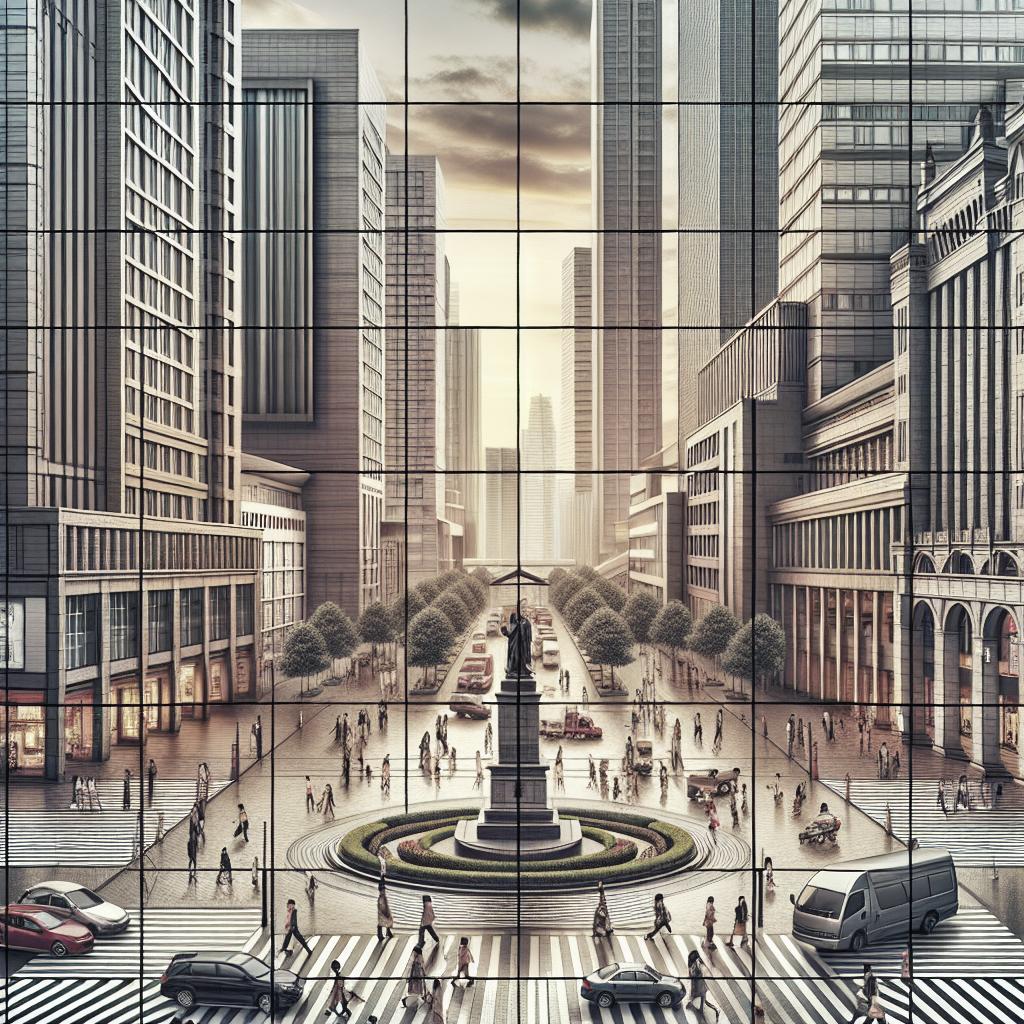<>
Urban photography is an ever-evolving discipline that can beautifully capture the dynamic essence of city life. One fundamental principle that many photographers swear by is the Rule of Thirds. This technique helps frame more engaging and balanced shots by breaking the image into equal thirds horizontally and vertically. However, an effective photographer not only learns and applies these rules but also understands when to bend or break them for creative exploration. In this blog post, we delve into the Rule of Thirds and how it can be used in various genres of urban photography, from portrait to street photography. Additionally, we’ll discuss its advantages, limitations, and how to leverage it as a guideline rather than a steadfast rule. Finally, we’ll list related articles and products that can further refine your urban photography skills.
In Focus: Basic Composition Techniques
Composition techniques form the backbone of any striking photograph. Understanding these basics can significantly elevate your artistry. Among popular composition techniques like leading lines and framing, the Rule of Thirds stands out for its simplicity and effectiveness. When you divide an image into nine equal segments using two horizontal and two vertical lines, placing your subject along these lines or their intersections creates a balanced and engaging photo. The Rule of Thirds is particularly helpful for beginners who often struggle with centering their subjects. By positioning essential elements off-center, the composition becomes less static and more dynamic. This technique encourages the viewer’s eyes to move through the image rather than settling in one spot. However, it’s crucial to remember that composition rules serve as guides rather than rigid constructs. Being too strict with any rule, including the Rule of Thirds, can stifle creativity. Therefore, understanding when and how to deviate from these norms is equally important.
Learn photography rules, learn to apply them, learn their advantages AND limitations. Finally, learn to bend them, break them and explore beyond them.
Every aspiring photographer starts by learning foundational rules. The Rule of Thirds, alongside other core principles, serves as an essential starting point for creating compelling images. However, understanding their advantages is only part of the journey; recognizing their limitations will enable you to transcend to higher levels of artistry. Once you comfortably apply these rules, it’s vital to understand scenarios where they may not be the best fit. Not every image benefits from the Rule of Thirds. For example, highly symmetrical scenes or minimalist compositions might look better with a centered subject. In such cases, adhering strictly to the Rule of Thirds can diminish your photo’s impact. Lastly, breaking the rules thoughtfully can lead to rewarding results. Experimenting beyond conventional boundaries often yields unique and striking images. This exploration distinguishes artists from mere practitioners, pushing the envelope of what photography can achieve.
Rules are prison cell walls for the creative mind so beware of them, don’t let them take over your life.
While rules like the Rule of Thirds offer excellent starting points, they can also confine creativity if followed too religiously. Treating them as rigid doctrines transforms these guidelines into barriers that restrict artistic freedom and innovation. Instead, approach these rules as flexible frameworks. They should inspire your creative process rather than inhibit it. Constantly challenging these norms not only sharpens your skills but also nourishes your artistic vision, enabling you to create more evocative and memorable images. Moreover, breaking away from established norms can often lead to fresh perspectives and innovative techniques. By pushing the boundaries of traditional rules, you not only evolve as a photographer but also contribute to the ever-expanding horizon of visual storytelling.
It’s better to consider them as “guidelines” only.
Embracing the Rule of Thirds as a guideline rather than a gospel can liberate your creative potential. Think of it as a helpful tool in your photographic toolkit, useful for certain situations while dispensable in others. Using guidelines allows for adaptability and responsiveness to different shooting environments and subject matters. It encourages intuitive choices and fosters creativity, enabling you to capture the essence of a scene in a way that’s authentic to your vision. Remember, the true power of any photographic rule lies in knowing when to employ it and when to set it aside. This sense of balance can make all the difference in producing work that resonates both technically and emotionally.
Rule of Thirds: A Quick Guide
To quickly apply the Rule of Thirds, start by visualizing your frame divided into nine equal parts. Your camera’s grid feature can be handy here. Place critical elements like the horizon, key subjects, or points of interest along these grid lines or their intersections. For instance, if you’re shooting a cityscape, aligning the skyline with the upper third line can create a balanced photo. For subjects, place them at the intersection points where the lines cross, providing a natural focal point for viewers’ eyes. Applying this rule effectively requires practice and experimentation. With time, it becomes almost second nature, and you’ll instinctively frame your shots in ways that are more engaging and balanced.
Portrait Photography
When it comes to portrait photography, the Rule of Thirds can be a game-changer. Positioning your subject off-center can help create a more dynamic and appealing composition. Try aligning the eyes along the top horizontal grid line or placing the face on one of the intersection points. By doing this, you invite the viewer to engage more deeply with the image, as their eyes naturally gravitate towards the subject. This off-center placement also leaves room for other interesting elements, like background details, which can add context and depth to the portrait. However, be mindful of the context and mood you want to convey. In more formal or intimate portraits, a centered composition might better suit the subject. Hence, always consider the emotions and narratives you aim to express when deciding on your composition.
Street Photography
Street photography often involves capturing fleeting moments and spontaneous interactions. Here, the Rule of Thirds can provide a valuable framework for quickly framing dynamic and engaging shots. Positioning key elements, such as people, buildings, or action points, along the grid lines can create a balanced and visually appealing photo. For example, if you’re photographing a bustling market scene, aligning a vendor or a striking architectural feature along one-third of the frame can add structure and balance to the chaos. This technique helps guide the viewer’s eye through the scene, making the photograph more approachable and impactful. Nevertheless, the unpredictable nature of street photography sometimes necessitates breaking the Rule of Thirds. Don’t be afraid to experiment with unconventional compositions if they better capture the essence of the moment. The key is to remain flexible and responsive to the environment, using the rule as a guide rather than a constraint.
Related Articles
1. Mastering the Basics of Urban Photography – This article dives into essential techniques and tips for capturing the essence of city life. 2. Exploring Composition Beyond the Rule of Thirds – Understand various composition techniques to enhance your photographic storytelling. 3. Portraiture in Urban Settings: Challenges and Techniques – Learn how to expertly photograph people in bustling urban environments.
Related Products
The right tools can significantly enhance your urban photography experience. Here are some essential products to consider:
Camera Selection
1. Sony A7 III – Known for its outstanding low-light performance and fast autofocus, ideal for street photography. 2. Canon EOS R5 – Excellent resolution and dynamic range make it a superb choice for detailed cityscapes and portraits.
Accessories
1. Manfrotto Befree Tripod – Lightweight and portable, perfect for steady shots in bustling urban settings. 2. Peak Design Slide Camera Strap – Provides comfort and versatility, a must-have for long photography sessions in the city.
Future Prospects
| Aspect | Description |
|---|---|
| Basic Composition Techniques | Introduction to core composition techniques like the Rule of Thirds to improve photographic balance and engagement. |
| Understanding and Applying Rules | Guidelines on how to effectively use and adapt composition rules for enhanced creativity. |
| Rule of Thirds in Portrait Photography | Using the Rule of Thirds to create dynamic and appealing portrait compositions. |
| Rule of Thirds in Street Photography | Application of the Rule of Thirds in spontaneous, dynamic street photography, and knowing when to break the rule for greater impact. |
| Related Content | Additional articles and products to further refine urban photography skills. |
By understanding and mastering the Rule of Thirds and other composition techniques, you’re well on your way to capturing compelling and balanced urban photographs. Embrace these guidelines but remain open to experimentation and innovation, ensuring your work not only follows the rules but also transcends them.


